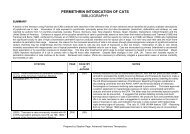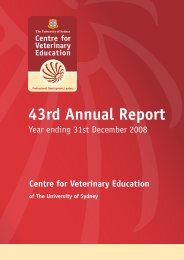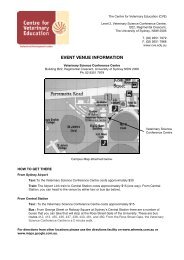CHAPTER 1: MOIST WOUND HEALING, MESSY OR NICE ...
CHAPTER 1: MOIST WOUND HEALING, MESSY OR NICE ...
CHAPTER 1: MOIST WOUND HEALING, MESSY OR NICE ...
Create successful ePaper yourself
Turn your PDF publications into a flip-book with our unique Google optimized e-Paper software.
<strong>CHAPTER</strong> 1: <strong>MOIST</strong> <strong>WOUND</strong> <strong>HEALING</strong>, <strong>MESSY</strong> <strong>OR</strong> <strong>NICE</strong>? MAXIMISING DRESSING USE ............................. 1PHYSIOLOGY OF <strong>WOUND</strong> <strong>HEALING</strong> ......................................................................................................................... 2FACT<strong>OR</strong>S AFFECTING <strong>WOUND</strong> <strong>HEALING</strong> ................................................................................................................. 2Local factors delaying wound healing ...................................................................................................... 4Potential dressing properties ................................................................................................................... 4Ideal dressing characteristics ................................................................................................................... 5Dressing classification .............................................................................................................................. 5Selection of dressings ............................................................................................................................... 51. <strong>WOUND</strong>S THAT REQUIRE SURGICAL RECONSTRUCTION – TENSION / MOTION .............................................................. 62.<strong>WOUND</strong>S THAT REQUIRE DRESSINGS THAT FACILITATE DEBRIDEMENT ........................................................................ 7Dressings that achieve debridement ........................................................................................................ 7a) Aggressive debridement: adherent dressings .................................................................................................. 7b) Modest debridement – Hydrogels ................................................................................................................... 83.<strong>WOUND</strong>S THAT REQUIRE DRESSINGS WITH ANTIBACTERIAL PROPERTIES ..................................................................... 9Dressings that have antibacterial properties ........................................................................................... 9a. Silver impregnated dressings / silver sulfadiazine (esp. burns) ...................................................................... 10b. Sugar / Honey ................................................................................................................................................. 10c. Maggots .......................................................................................................................................................... 104. <strong>WOUND</strong>S THAT REQUIRE DRESSINGS THAT ARE NON ADHERENT AND DO NOT INTERFERE WITH <strong>WOUND</strong> CONTRACTION ANDEPILETHIALISATION ........................................................................................................................................... 11Dressings that are non adherent............................................................................................................ 11Perforated polyurethane membranes ................................................................................................................ 11Paraffin gauze ..................................................................................................................................................... 12Silicone Mesh ..................................................................................................................................................... 125.<strong>WOUND</strong>S THAT REQUIRE DRESSINGS THAT HAVE ABS<strong>OR</strong>PTIVE CAPACITY ................................................................... 13Dressings with absorptive capacity ........................................................................................................ 13Advantages ......................................................................................................................................................... 13Disadvantages .................................................................................................................................................... 13Foams ................................................................................................................................................................. 13Cotton Wadding/ gamgee .................................................................................................................................. 14Other dressings ...................................................................................................................................... 14Dressings that are vapour permeable ................................................................................................................ 14Vapour permeable films ................................................................................................................................ 14Dressings with potential bioactivity ................................................................................................................... 14Alginates ....................................................................................................................................................... 14Hydrocolloid .................................................................................................................................................. 15W<strong>OR</strong>LD WIDE <strong>WOUND</strong>S - PAPER........................................................................................................................ 16AN INTRODUCTION TO THE USE OF VACUUM ASSISTED CLOSURE ................................................................................ 16KEY POINTS .................................................................................................................................................... 16ABSTRACT ...................................................................................................................................................... 16INTRODUCTION ............................................................................................................................................... 16DEVELOPMENT OF THE VACUUM ASSISTED CLOSURE TECHNIQUE ............................................................................... 17VACUUM ASSISTED CLOSURE: MODE OF ACTION ..................................................................................................... 18CLINICAL EXPERIENCES WITH VAC ....................................................................................................................... 19COST OF TREATMENT ........................................................................................................................................ 20METHOD OF USE ............................................................................................................................................. 20THE FUTURE OF VACUUM ASSISTED CLOSURE ......................................................................................................... 23BOX 1: INDICATIONS AND CONTRAINDICATIONS F<strong>OR</strong> THE USE OF VAC ........................................................................ 23<strong>CHAPTER</strong> 2: INITIAL MANAGEMENT OF ACCIDENTAL <strong>WOUND</strong>S ................................................................ 27<strong>WOUND</strong> - CLASSIFICATION ................................................................................................................................ 28CVE, Wound Management and Reconstruction, Proc. No. 400
LATERAL CAUDAL ............................................................................................................................................. 99REVERSE SAPHENOUS CONDUIT FLAP ................................................................................................................. 100BRACHIAL ..................................................................................................................................................... 101CRANIAL SUPERFICIAL EPIGASTRIC ..................................................................................................................... 102COMPLICATIONS ............................................................................................................................................ 103<strong>CHAPTER</strong> 6: FREE SKIN GRAFTS ............................................................................................................... 105TYPES OF GRAFTS .......................................................................................................................................... 105RECIPIENT <strong>WOUND</strong> SITE .................................................................................................................................. 107Appropriate sites .................................................................................................................................. 107Inappropriate sites ............................................................................................................................... 107PERF<strong>OR</strong>MING SKIN GRAFTS .............................................................................................................................. 108Recipient site preparation .................................................................................................................... 108Donor site preparation ......................................................................................................................... 109Graft placement ................................................................................................................................... 111Graft Management .............................................................................................................................. 111Graft Take ............................................................................................................................................ 112Typical graft colour changes ................................................................................................................ 113CVE, Wound Management and Reconstruction, Proc. No. 400






